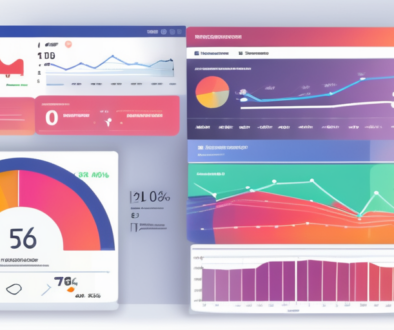Marketing Metrics And KPIs – Email, Social Media, Analytics, and Everything In Between
Introduction:
In this guide, we’ve outlined the key metrics and methodologies we believe will help your company better meet the needs of your clients and show continued value. The goals of this document are:
- Create a reference for your company to use when in need of quantitative objectives for clients
- Outline key performance indicators (KPIs) for Marketing
- Show how to convert business KPIs into a real dollar value. This will also allow us to estimate how changes in one or two key metrics may impact business revenue
A Note About Metrics:
In the world of metrics and analytics, it’s easy to get lost in the data. There are literally thousands of different metrics to track. We’ve intentionally kept this document short to focus on the metrics that matter most to the successful business growth of your clients.
There may be things missing that you will add back to specific clients, but this is intentional. We want to focus on the things that make a real, tangible difference in the business without being distracted by unimportant metrics.
Marketing KPIs:
Website:
As a marketing tool, a website is one of the very best tools we have available. A good website is the “home base” for our marketing efforts. Social media (Facebook, Twitter, Instagram, etc.) functions like an outpost. They represent our brand, but the user almost always needs to come back to base to convert.
Our websites should be focused on providing conversions. That means the user needs to take an action when they get to our site. These actions will be dependent the needs of the business.
Macro Conversions – Macro conversions are the big, clear conversions users make on the website. These are the conversions that are directly tied to revenue for the business. Here are some of the most common examples of macro conversions:
- Online purchases
- Contact form submissions
- Phone calls
- Subscription signups
Micro Conversions – The next set of goals to track are micro conversions. Micro conversions do not necessarily lead directly to revenue, but they allow us to begin developing a relationship with the user. Examples of micro conversions include:
- Email list signups
- Whitepaper/PDF downloads
Tracking – To track these conversions, we typically use Google Analytics. Google Analytics allows us to setup goal tracking using URL or event based engagement. The details of setting these up depend on the nature of the goals, and more detail on doing so can be found here.
Conversion Rate – An important metric to monitor is the conversion rate of a website. The conversion rate is a measure of how good a website is at turning traffic into leads. The conversion rate is based on the following formula:
- Number of visitors who complete a goal/number of visitors
Close Rate – The close rate is the ability of the business to turn a lead into a sale. It is calculated as.
- Number of Closed Sales/Number of Leads
Website KPIs in Review:
In addition to tracking the actual conversion, we want to understand what drove that conversion. We do this by tracking the conversion against the source (where the visitor came from) as well as the landing page (the first page the visitor hit when they arrived).
- Macro conversions
- by Source (Google, Facebook, email marketing, etc.)
- by Landing page (What was the first page they landed on when they arrived?)
- Micro Conversions
- by Source (Google, Facebook, email marketing, etc.)
- by Landing page (What was the first page they landed on when they arrived?)
- Conversion Rate: Number of visitors who complete a goal/number of visitors
- The conversion rate helps us understand how good your website is at turning traffic into conversions. Although we only
Converting Marketing KPIs to Real $$$ Value:
In order to convert the above marketing KPIs to a dollar value, we need to know a couple of key pieces of information about the business. This should be part of any successful measurement campaign. This is where we turn abstract metrics into concrete business value.
First, we need to know the lifetime customer value (LCV) for each new customer. This is the amount of money paid to your business over the lifetime of the customer. It is the most accurate way to analyze the value of customer over the long run.
Second, we need to understand our customer acquisition cost (CAC). CAC is calculated by taking all the marketing expenses for a given period and dividing that by the number of new customers acquired.
For example, if a company spends $3,000 on marketing per month, and they gain 100 customers in that month, their customer acquisition cost is $30 per customer. If the lifetime value per customer is $50, the net revenue per customer is $20.
In a formula it looks like: LCV – CAC = Net Revenue Per Customer
A Detailed Example – From Traffic to Net Revenue:
So let’s take website traffic and using the above functions convert it to real revenue.
First we’ll take total website traffic (let’s say 1000 visitors) by conversion rate (let’s say 2.7%).
- 1000 Visitors x 2.7% Macro Conversion Rate = 27 Conversions
Now we need to determine the close rate for leads (how many leads are we able to convert into real customers?). In this case, let’s say our close rate is 75%
- 27 Conversions x 75% Lead Close Rate = 20.25 Total New Customers
We then take the 20.25 and multiply it by the Lifetime Value of our Customer. In this case, let’s say it’s $500.
- 20.25 Total New Customers x $500 LTV = $10,125 Gross Revenue
Now we subtract our marketing expenses. Let’s say we spent $4,000 on marketing this month.
- $10,125 Gross Revenue – $4,000 Marketing Expenses = $6,125 Total Net Revenue
And that is how we turn some basic web metrics into real, tangible value for a company. We can rework this formula for micro conversions as well, but understanding it at a macro level is most valuable as we start to measure our marketing success.
Social Media:
There is a temptation in social media (as in all analytics) to track metrics that don’t drive real business value. For example, knowing the time to post content is important for doing social media well, but it doesn’t show us any true value on the business. For client side reporting, we’ll focus on showing real value through our metrics.
For social media, we’ll be using Conversation Rate, Amplification Rate, Applause Rate, and Economic Value in order to understand our success on social media on the business. Below are the formulas to calculate each of the metrics:
Conversation rate = Number of comments/Number of posts
Applause rate = Number of likes, favorites, etc./Number of posts
Amplification rate = Number of shares or retweets/Number of posts
Economic value = Dollar value of social media conversions/Number of posts
The formulas above are designed to capture the value of social media holistically. It can be tempting to see economic value as the sole measure of social media success, but that is an incomplete picture. The branding and long term value of a successful social media campaign can be much better captured by using Conversation, Applause, and Amplification rates.
The best tool we’ve found to track these metrics is TrueSocialMetrics. TrueSocialMetrics allows you to acquire the last 30 days of information for free. We recommend pulling weekly numbers and keeping them in a Google Sheet. We can then use this data to analyze trends over time.
Example Social Media Reporting:
Below is an example report utilizing the above metrics. These metrics should be tracked over time to look for trends in the data. For example, using a free True Social Metrics account, we can pull this data every month (or even every week) into Excel/Google Sheets and then look for changes over time.
Example Social Media Report:
| Blog | YouTube | ||||
| Applause | 1.08 | 2.78 | 1.67 | 2.3 | 1.4 |
| Amplification | .86 | 1.5 | 3.4 | .89 | 0 |
| Conversation | 1.3 | 1.76 | .4 | 3.4 | 3.5 |
| Economic Value | $4.50 | $2.30 | $6.90 | $4.05 | $1.20 |
Search/SEO:
Within the world of organic search lie some of the greatest challenges and the greatest opportunities for marketing. Search can be a huge driver of traffic and conversions when done well.
We don’t dig into how to actually do SEO in this document, but we will cover multiple ways to measure SEO on your site.
Keyword Data:
Unfortunately, the keyword data available in Google Analytics isn’t very helpful because there isn’t very much of it. Therefore, we won’t be able to use it here.
What we will use: rankings, organic traffic by page, and conversions by landing page from organic traffic.
Rankings:
Once you’ve established your keyword research and have begun SEO in earnest, one of the most powerful factors of SEO is rankings. Are you ranking for the keywords that matter? Are your rankings improving month over month or week over week for the queries that you are targeting? For this metric there are no fancy calculations. It’s simply determine are your rankings improving for the keywords that matter?
There are multiple tools to track rankings, but one of our favorites is the Moz suite of tools available at http://moz.com/.
Organic Traffic and Conversions:
Within Google Analytics we need to then figure out a way to measure if our SEO efforts aren’t just ranking us, but whether they are driving traffic and conversions. We do this by looking at two reports.
First we segment our data to look at organic search traffic by landing page. Using our sessions metric, we can see which pages are driving the most sessions via organic search. This also helps us understand what keywords people are using to find out site. Although we don’t know the exact keywords, we can understand what traffic is coming to our site by topic. If we have a blog about a particular topic that is getting thousands of hits from organic search, we can deduce that keywords around that topic are driving large numbers of organic search results.
Next we want to break out organic search conversions by landing page. We are again just sorting the traffic into organic search, but we are then seeing which visits drove conversions (both macro and micro) based upon organic search. Typically we find this doesn’t mirror exactly to the traffic listing, but tends to focus on a handful of queries that show the value we provide to users.
Paid Ads/PPC:
PPC is one of the simplest of all ad campaigns to measure. We will use the following metrics:
- Impressions – How many people see the ad?
- Clicks – How many people actually clicked on the ad?
- Conversions – How many people did something on our website after coming from PPC?
When these two metrics are combined you get the conversion rate for the ad (number of clicks/number of impressions). This conversion rate helps us understand which ads are working best.
Beyond impressions and clicks, we want to know how much a click is costing (called the cost per click), the conversion rate of your website for PPC, as well as the lifetime value of a customer.
The formula then looks like this.
(Number of website conversions from PPC x Customer lifetime value) – Ad Spend = Revenue from PPC
This will give us a good understanding of the value we’re gaining from the PPC ad campaigns we’re conducting.
Email Marketing:
Email can be one of the most valuable channels for marketing. When you get someone’s email address, they are giving you permission to market to them on a continued basis. That is an amazing opportunity!!!
The standard metrics for email marketing are as follows:
List Size: The size of your email list does impact the revenue it generates. You’re likely already tracking list subscribes under micro conversions, so now we just want to make a note of all unsubscribes.
Open Rate: Out of your entire list, what percentage of people actually open the email?
Click-thru Rate: What percentage of people on your list clicked through to your offer or blog post?
Conversions: Conversions from an email campaign are tracked via Google Analytics when UTM codes are applied to the campaign.
Constant improvements in these metrics will provide meaningful business growth to your organization.
Closing Thoughts:
As we mentioned in the introduction, there are literally thousands of potential metrics we could track. But ultimately, we want to report things to the client that show real business value. In this guide we’ve done our best to sort through the mess of metrics and bring solutions that allow you to accurately predict and understand real business value.
If there is something you’d like to see added or if anything is unclear, please feel free to reach out.


